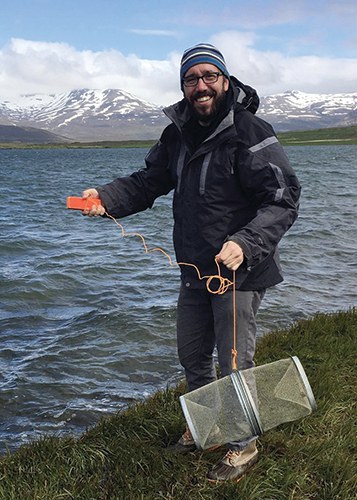Posted: December 2, 2022
Some wildlife may adapt to climate change.

Lead researcher Jason Keagy, assistant research professor of wildlife behavioral ecology, is shown on the bank of an Icelandic lake holding a fish trap during a collection of threespined sticklebacks for the study. Credit: Janette Boughman
Innovative research shows that populations of a small fish that live in both Iceland's lakes and marine waters respond more quickly and differently to predators after they invade new freshwater lakes, demonstrating how some animals can adapt rapidly to changes in their environments and may be able to adapt to climate change.
The study of threespine sticklebacks, spearheaded by a Penn State wildlife behavioral ecologist, involved the development of a robotic trout predator, the introduction of the scent of arctic char preying on sticklebacks, and painstaking measurements of sticklebacks' reaction time to both those visual and olfactory predator cues. The laboratory experiments included fish that were collected in saltwater estuaries along the Icelandic coast and from both crystal-clear spring-fed lakes and lakes clouded by the runoff from melting glaciers.
The researchers focused on the threespine stickleback fish because it is considered an evolutionary model due to the exceptional capacity of marine populations to repeatedly invade freshwater habitats across the Northern Hemisphere, according to Jason Keagy, assistant research professor of wildlife behavioral ecology.
"Those incursions from the ocean into lakes have caused well-documented adaptation in physiology, morphology, life history, and behavior of the fish," he said. "Iceland provides a unique opportunity to study rapid adaptation to novel environments because of a large network of geologically young--maximum 14,000 years old to a minimum of just 50 years old--lakes spread across multiple watersheds, providing natural replication."
The researchers experimentally measured anti-predatory responses of wild-caught sticklebacks from marine, lowland spring-fed, highland spring-fed, and highland glacial lakes, sequentially exposing fish to both olfactory and mechano-visual predator cues. All populations were tested in two light conditions, simulating the visual properties of typical spring-fed and glacial lakes, as measured via spectrophotometry, and thus representing both their native and a new visual environment.
Comparing reactions between light treatments allowed the researchers to gauge the level of "plasticity" in anti-predatory behavior of fish from different habitat types, depending on immediate visual conditions. Plasticity is the flexibility of an organism to deal with changes in its environment or differences between its various habitats.
"The design of our study allowed us to make inferences on evolutionary changes in behavior by comparing the magnitude and direction of change between marine fish--which represent the ancestral state--and highland freshwater fish, expected to be most genetically distant from marine fish," Keagy said.
--Jeff Mulhollem
Features
Breaking the Silence on Farm Stress
Farming has always been a demanding profession, but today's farmers face unprecedented pressures that can severely impact their mental health.
Biting Back
Research Targets Vector-Borne Diseases to Save Lives
Leading Forward
Ott brings deep connection to role of dean.


